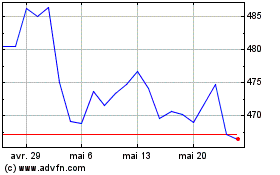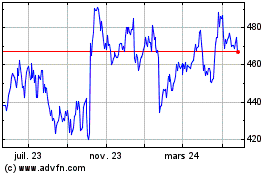Independent Review Urges Continuation of James Webb Telescope for 'Compelling Science'
27 Juin 2018 - 9:46PM
Dow Jones News
By Andy Pasztor
Launch of NASA's troubled James Webb space telescope will be
delayed another year to March 2021 and development costs will climb
10% above revised targets announced just three months ago, creating
further congressional turmoil for the agency's top astronomy
project.
The further slips and an estimated price tag of $8.8 billion
were announced Wednesday, including projections that mistakes by
production employees of prime contractor Northrop Grumman Corp.
will amount to a $600 million hit to the program. The findings were
included in the report of an independent review board previously
set up by the National Aeronautics and Space Administration to
study the project and recommend a way forward.
The review reiterated that a series of design, production and
quality-control lapses caused the latest difficulties, many of
which could have been avoided or solved by "simple fixes that were
not implemented," according to Thomas Young, a retired NASA and
industry official who headed the outside panel. But despite nagging
problems that reappeared years after lawmakers added funding for
the high-profile project and NASA managers significantly pushed
back the anticipated launch date at least twice before, Mr. Young
told reporters his group unanimously agreed the ambitious space
telescope should be completed in light of "the compelling science"
it promised.
In his remarks Wednesday, Mr. Young said that as recently as
March, when NASA delayed the projected launch date to May 2020 from
June 2019, "too much optimism had been built into the schedule." He
also told reporters "I don't think anybody can tell us today"
whether further problems will crop up to prompt additional
delays.
Originally slated to be launched in 2007, the space telescope is
intended to travel farther into space that any previous observatory
to try to study origins of stars and potentially identify other
planets capable of supporting life.
Mr. Young said he had 80% confidence that the latest schedule
and cost estimates will be met. For James Webb to continue,
lawmakers will have to approve the new cost ceiling, which exceeds
a firm congressionally imposed cap of $8 billion in place since
2011.
Before the press conference, a NASA public affairs official said
James Bridenstine, the agency's chief, had sent a message to
employees expressing his "unwavering support" for the space
telescope.
Northrop Grumman, which previously revamped its production
procedures and agreed to strict new government oversight
requirements, has been criticized because workers installed 16
valves on the satellite's thrusters without relying on detailed
instructions and in the process used the wrong cleaning
compound.
Resulting leaks required a subcontractor to refurbish the
valves, followed by another time-consuming process to replace and
retest them. It took about three months to complete the process,
one person familiar with the details said.
When workers deployed a sun shield designed to protect the
spacecraft's intricate gold, hexagonal-shaped mirrors in space, the
operation took twice as long as expected and revealed shortcomings
despite earlier successful tests with a one-third-scale
replica.
Cables that pull the shield into shape "develop too much slack
during the deployment, creating a snagging hazard," Thomas
Zurbuchen, NASA's associate administrator for unmanned missions,
said earlier this year.
Several tears also appeared in the shield, because of unexpected
stresses stemming from workers' incorrectly attaching hooks and
cables to the wrong holes. Several of those fasteners still haven't
been retrieved, NASA officials said Wednesday.
Write to Andy Pasztor at andy.pasztor@wsj.com
(END) Dow Jones Newswires
June 27, 2018 15:31 ET (19:31 GMT)
Copyright (c) 2018 Dow Jones & Company, Inc.
Northrop Grumman (NYSE:NOC)
Graphique Historique de l'Action
De Juin 2024 à Juil 2024

Northrop Grumman (NYSE:NOC)
Graphique Historique de l'Action
De Juil 2023 à Juil 2024
